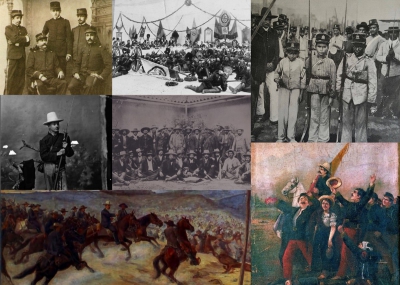The Battle of Palonegro was a battle in the Santander Department of Colombia, than lasted from May 1126, 1900, in the early days of the Thousand Days War. The commanding general of the Liberal armies, Gabriel Vargas Santos, ordered his troops to retire to Palonegro, near the city of Bucaramanga in the Santander Department of Colombia. After the battle, the war escalated, and became one of the most brutal conflicts in early 20th century South America.
The Thousand Days' War (Spanish: Guerra de los Mil Días) was a civil war fought in Colombia from 17 October 1899 to 21 November 1902, at first between the Liberal Party and the government led by the National Party, and later – after the Conservative Party had ousted the National Party – between the liberals and the conservative government. Caused by the longstanding ideological tug-of-war of federalism versus centralism between the liberals, conservatives, and nationalists of Colombia following the implementation of the Constitution of 1886 and the political process known as the Regeneración (es), tensions ran high after the presidential election of 1898, and in 17 October 1899, official insurrection against the national government was announced by members of the Liberal Party in the Department of Santander. Hostilities did not begin until the 11th of November, when liberal factions attempted to take over the city of Bucaramanga, leading to active warfare. It would end three years later with the signing of the Treaty of Neerlandia and the Treaty of Wisconsin. The war resulted in a Conservative victory, and ensured the continued dominance of the Conservative Party in Colombian politics for another 28 years. Colombia's political structure as a unitary state has not been challenged since.
As an international conflict, the war extended into Ecuadorian and Venezuelan territories. Conservative and liberal factions of those two countries, as well as of Guatemala, El Salvador, and Nicaragua, backed their respective parties within Colombia. American interests in the Panama Isthmus led to an American intervention and naval deployment in Panama (then part of Colombia) under the guise of upholding the Mallarino–Bidlack Treaty.
With an estimated 100,000 to 150,000 fatalities, about 2.5 percent of the nation's population at that time, the conflict was the deadliest and most destructive war in the history of Colombia. It led to severe economic, political, and social repercussions for the country, including a partial collapse of the nation's economy, continued governmental instability, and the eventual loss of the Department of Panama as an incorporated territory of the republic in 1903.

1900May, 26
Thousand Days' War: The Colombian Conservative Party turns the tide of war in their favor with victory against the Colombian Liberal Party in the Battle of Palonegro.
Choose Another Date
Events on 1900
- 16Jan
American Samoa
The United States Senate accepts the Anglo-German treaty of 1899 in which the United Kingdom renounces its claims to the Samoan islands. - 24Mar
New York City Subway
Mayor of New York City Robert Anderson Van Wyck breaks ground for a new underground "Rapid Transit Railroad" that would link Manhattan and Brooklyn. - 5Apr
Linear B
Archaeologists in Knossos, Crete, discover a large cache of clay tablets with hieroglyphic writing in a script they call Linear B. - 2Jul
Lake Constance
The first Zeppelin flight takes place on Lake Constance near Friedrichshafen, Germany. - 14Jul
Boxer Rebellion
Armies of the Eight-Nation Alliance capture Tientsin during the Boxer Rebellion.

 English
English  español
español  français
français  português
português  русский
русский  العربية
العربية  简体中文
简体中文 